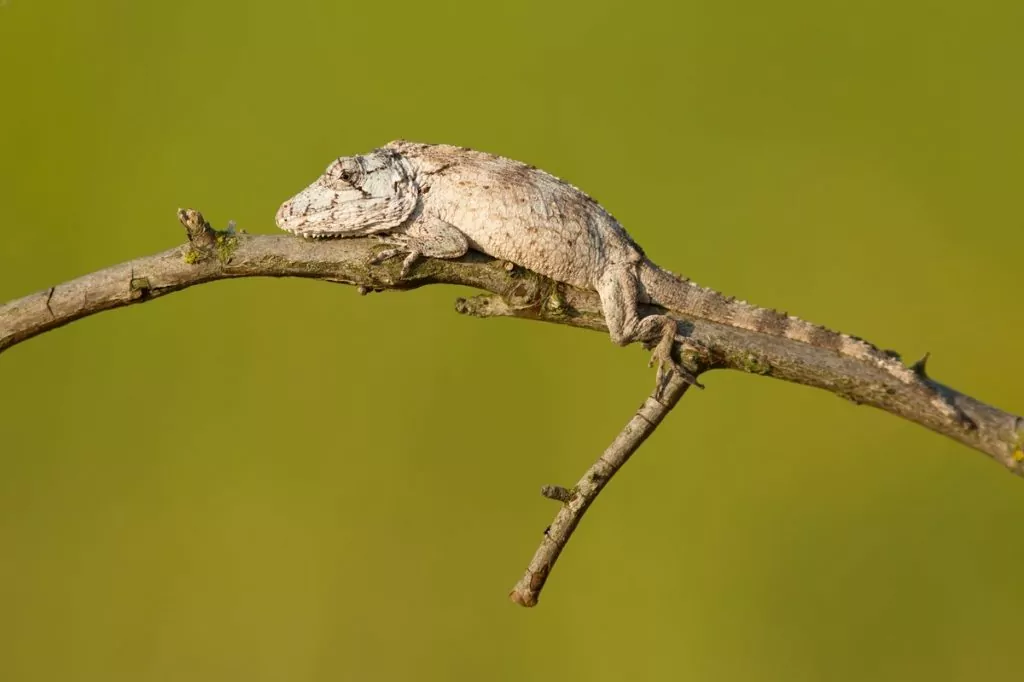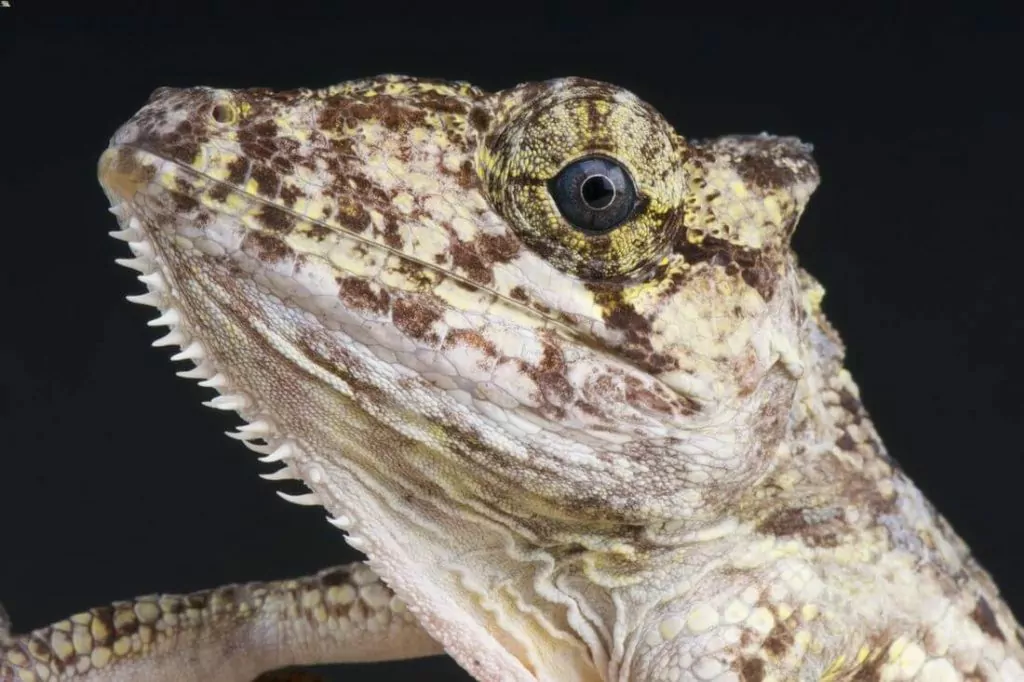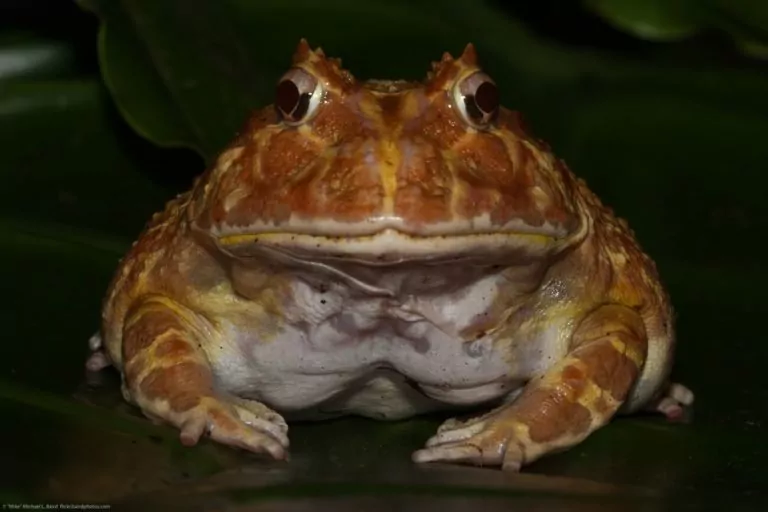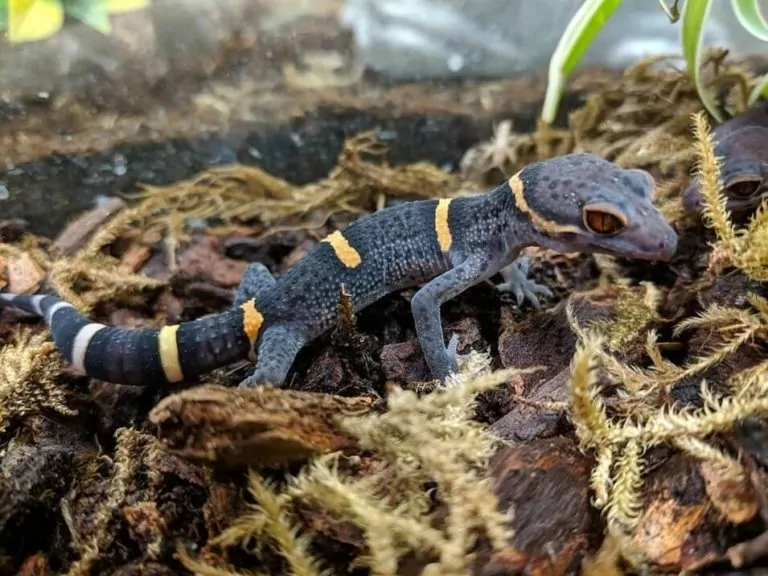Cuban false chameleons are interesting creatures that can make great pets for the right kind of owner. If you’re into quirky and unique lizards, this species might be for you!
However, you’ll need to do some research before you jump into ownership. These reptiles require some very specific conditions in order to thrive in captivity.
This guide makes things simple by covering all the essential information you need to know about Cuban false chameleon care.
Let’s get started.
Table of Contents
Species Summary
If you’re searching for a standout lizard species to care for, look no further than the Cuban false chameleon (Anolis barbatus). While these critters look like chameleons at first glance, they actually belong to the anole genus!
This reptile has a very distinct look, making it a prized pet lizard in the herpetology community. With its unique eyes and alien-like head, the Cuban false chameleon is a joy to observe!
Originally from the jungles of Cuba, these lizards spend most of their time in trees. Because of this, they require plenty of climbing surfaces and natural decor to stay happy.
Appearance & Colors
Many in the reptile community refer to the Cuban false chameleon as an “alien” species. Take one look at them and it’s not hard to see why! They have a mishmash of features that create a truly unique look.
The head is triangular in shape and features a bony casque at the rear. It adds substantial size to the head, giving the lizard some extraterrestrial vibes. Not only that, but the lizard is sporting conical chameleon-like eyes.

The eyes can move independently, which is why so many people mistake this species for a chameleon. Under the chin, these lizards have barbel-like scales. They are flexible to the touch, but interesting nonetheless!
The body is quite bulky. Unlike other tree-dwelling species, false chameleons have short and stout tails. Oftentimes, it’s shorter than the rest of the lizard’s body. These creatures also sport short limbs, which help them navigate narrow branches.
When it comes to color, the Cuban false chameleon is muted. It takes on shades of brown and mossy green. These colors help the lizard blend into its surroundings and stay safe.
Expert Tip: It’s not uncommon for there to be a slight cluster of color and patterns near the neck, but this isn’t the case all the time.
Lifespan
Unfortunately, these interesting-looking reptiles don’t have the longest lifespan. On average, the lifespan of a Cuban false chameleon is between three and six years in captivity.
That’s considerably shorter than other popular reptile species, such as the leopard gecko and common iguana.
Don’t let that shorter lifespan deter you though! As long as you provide the right living conditions and care, your time with the Cuban false chameleon will be quite enjoyable.
Average Size
The average size of a Cuban false chameleon is about six to seven inches from snout to vent. Their fairly short tail adds a couple of extra inches to their overall size measurement.
Females are generally a bit smaller than males, but the difference is minor. You won’t see any significant differences in build either.
Expert Tip: In order to give your false chameleon great odds of growing big and strong, provide them with great care and purchase them from an experienced seller.
Cuban False Chameleon Care
Cuban false chameleon care can be quite a fun and rewarding responsibility. However, they can be a bit more challenging than your average reptile.
Primarily, they have some distinct dietary and environmental needs that you have to meet if you want them to thrive. While they don’t seem that difficult on paper, it’s important to have a thorough understanding before attempting to own one of these lizards for yourself.
Below are the most important care guidelines that you’ll need to follow.
Enclosure Size
Let’s start with the enclosure. You can keep Cuban false chameleons in a wide variety of enclosures. These include standard aquarium tanks or open cages.
That said, we recommend housing them in a vivarium-style enclosure. These units contain vents and glass doors, which can do wonders to maintain humidity levels.
Because they are arboreal, height is the most important thing you should focus on. Your lizard’s new home should measure at least 24 inches long, about 18 inches wide, and 24 inches tall.
Expert Tip: If possible, scale up to an enclosure that’s 36 inches long and 36 inches tall. An enclosure of that size will provide more climbing room.
Habitat Setup
As with any arboreal species, climbing surfaces are a must when it comes to their habitat setup! Create a network of paths using branches, perches, and vines. A couple of wider branches are good for lounging.
However, these lizards don’t need huge branches to get by. They do quite well with thinner branches, too. This means you can easily create more paths by keeping the width of each branch relatively thin.
On the bottom of the enclosure, use an absorbent substrate of sphagnum moss or coconut coir (fertilizer-free soil works well too). Regardless of what you choose, the material needs to hold onto moisture to keep humidity levels high.
To put the finishing touches, add plenty of plants. You can use live plants. However, we recommend sticking to plastic and silk varieties to keep your maintenance duties a bit more manageable.
Temperature & Lighting
Cuban false chameleons need a temperature gradient to thermoregulate. That means one side of the enclosure has to be warmer than the other.
The hot side will be the basking side! Your lizard will use it to warm up and lounge around. Place a 50-watt basking light about 10 inches above the tallest perch. Make sure that it’s out of reach!
Here are the temperatures to aim for in both sides of the enclosure:
- The basking light should raise the temperature in that corner to about 90 degrees Fahrenheit.
- For the cooler side, let temperatures fall to about 78 degrees. If the ambient temperatures get any cooler than that at night, use a heat emitter to keep your lizard comfortable.
Expert Tip: A UVB light is another important addition. Cuban false chameleons need UV rays to synthesize calcium and stay healthy. Shine a UVB lamp on most of the enclosure and set it on a timer. These lizards need a minimum of 10 hours every day.
Humidity
Maintaining high humidity levels is one of the biggest challenges owners face when it comes to Cuban false chameleon care..
These reptiles need an environment with 70 percent humidity at all times! The easiest way to raise the humidity is to mist the enclosure daily. The substrate will hold onto moisture and keep things damp.
An automatic dripper is a good option as well. In fact, it may be an even better choice due to the lizard’s water needs (more on that in the section below).
Expert Tip: Do yourself a favor and invest in a high-quality hygrometer! This simple piece of equipment will help you keep track of humidity levels to maintain consistency and avoid major health issues.
Water
Good hydration is a must. However, Cuban false chameleons don’t lap up water from a bowl. Instead, they drink from leaves and flat surfaces!
You can include a small water bowl in the enclosure as another enrichment item. The lizard may use it to soak and cool off.
But to ensure that they’re staying hydrated, many owners like to install a drip system. Place the drip system above a smooth horizontal surface, such as a perch or large leaf.
Expert Tip: Before you do that, make sure that your enclosure has proper drainage. While humid environments are important, you don’t want to soak the substrate or experience any mold issues.
Food & Diet
Interestingly enough, Cuban false chameleons don’t survive on insects alone like other reptiles. In the wild, these creatures actually eat wild snails!
But don’t go picking snails from the garden. Chances are, those snails are rife with disease. Plus, they could contain nasty pesticides.

Instead, go to a snail supplier or pet retailer. Snails from a reputable supplier will be clean, parasite-free, and safe for your lizard.
Provide a single snail about twice a week. The Cuban false chameleon will eat the snail inside and spit out the shell.
To supplement the snails, provide a couple of insects every day. Two or three crickets will do just fine. You can also dust them with calcium and multivitamin powders every other feeding for good measure.
Potential Health Issues
Cuban false chameleons can encounter all of the usual diseases that reptiles in captivity face. They are susceptible to issues like respiratory infections, parasites, and a variety of skin problems.
Most of those common ailments are avoidable though. Respiratory infections tend to rear their ugly heads when humidity levels and temperatures aren’t right. Meanwhile, parasites and bacteria-focused ailments come from an unhygienic home.
With proper habitat conditions and monthly sanitization, these health issues shouldn’t be a problem.
Cuban false chameleons can also suffer from eye problems, making that a particular ailment for owners to watch out for. Their unique eyes put them at a higher risk for eye infections.
Again, regular cleanings and monthly sanitizations will do a lot to prevent ocular problems. But if you start to see swelling or discharge, bring your lizard to a vet for the proper antibiotic treatment.
Cuban False Chameleon Behavior & Temperament
Cuban false chameleons are not as flighty as some other species. They can still be shy, but most will calm down after getting comfortable with their environment.
But don’t expect to see a ton of activity from this lizard! They will move around as they thermoregulate, but are quite relaxed compared to other popular reptile species.
The only exception is when two males are in the same vicinity. Male Cuban false chameleons are very territorial, meaning you should never keep them in the same enclosure. Otherwise, fighting will ensue!
Males need to be separate at all times. Not only that, but they shouldn’t even have sight of each other (even if they’re in separate enclosures). This will cause them to get riled up and be constantly stressed.
Expert Tip: Cuban false chameleons are usually not aggressive with humans. They prefer to intimidate rather than bite. These lizards will open their mouths and stick out their tongues as a warning. If this happens, give them some space!
They can bite you if you press further. But if you let them relax, they will not attempt to nip you.
Handling Tips
Once your Cuban false chameleon gets comfortable with you, it should not have a problem with handling. However, it’s important to start handling them early on so that they get used to that socialization.
The best way to pick them up is by sliding your hand under their body and feet. These reptiles have a blind spot under the body. This means they’re more likely to move from their branch to your hand if you approach in that manner.
Always keep an eye on your lizard’s response. If they display that show of intimidation we went over in the section above, back off. Let your lizard go into your hand on their own and never force handling. A little patience and understanding will go a long way.
Conclusion
As long as you do your research and are prepared to put in the necessary work to keep these reptiles happy, Cuban false chameleon care shouldn’t give you any trouble.
A large part of it is simply understanding the needs of these special lizards, and how you can help them live a long and happy life. After that point it’s all about being consistent and attentive!
We’re more than happy to discuss any questions you have about this species. It’s definitely a bit out of the ordinary, so we understand why a little extra information might make it easier to decide if you want one or not!


